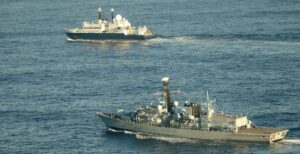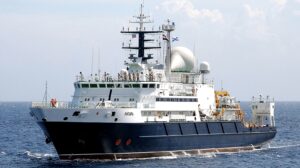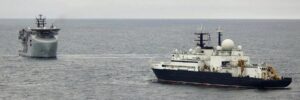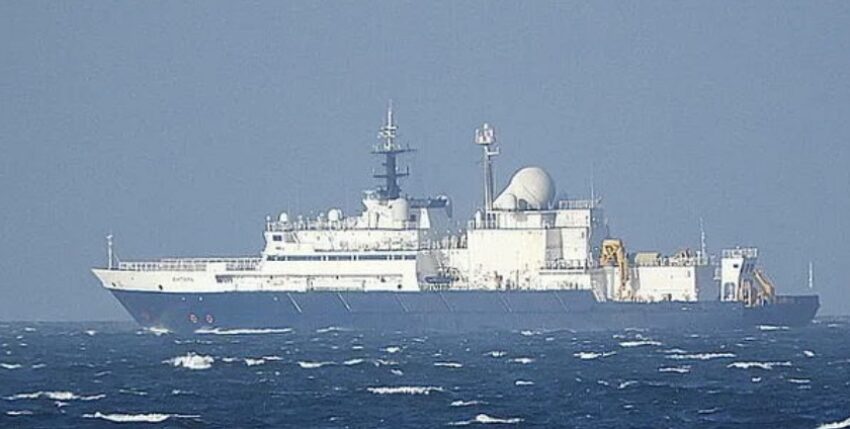"Yantar" - Russian reconnaissance ship: activities at the turn of the year 2024/25 and international reactions
"Yantar" - research vessel or espionage threat?
The Russian reconnaissance ship "Yantar" is once again causing unrest in European waters. Officially listed as an oceanographic research vessel, it is suspected of exploring critical underwater infrastructure.
Western security analysts are keeping a close eye on the ship, as it could potentially be used for espionage operations and sabotage. Particular attention was paid to "Yantar" during his most recent missions around the turn of the year.
Observations in European waters
December 2024 - Spain & Algeria
- In mid-January "Yantar" discovered in the sea area between Spain and Algeria.
- That's exactly where the Russian cargo ship was on 24 December Ursa Major which was known for the so-called "Syria Express".
- Cause of the sinking: Explosion in the engine room. Allegedly, important components for the construction of a Russian nuclear icebreaker were on board.
January 2025 - Mediterranean & North Sea
- After a harbour stopover in Algiers "Yantar" presumably after wreckage of the Ursa Major.
- The ship left the Mediterranean on 17 January and was closely monitored by NATO naval forces.
- In the Strait of Dover "Yantar" from British frigates HMS Somerset and HMS Tyne accompanied.
- On 24 January, the ship anchored in the Kattegat near Aalbek Bay.
- Here, it was used by Danish units, including HDMS Niels Juelmonitored.
- On 25 January "Yantar" continued its journey in the direction of Murmansk.

Yantar and the Russian Directorate of Deep-Sea Research (GUGI): A secret mission?
The "Yantar" belongs to the fleet of the "Russian Directorate of Deep-Sea Research" (GUGI), a secret department of the Russian Navy that specialises in underwater operations. GUGI operates both specialised submarines and research vessels, including the large submarine "Belgorod" and the units "Losharik", "Kashalot" and "Paltus". The tasks of this fleet include the exploration and manipulation of underwater infrastructures as well as reconnaissance and sabotage operations.
Reporting directly to the Russian Ministry of Defence, GUGI has its headquarters in Saint Petersburg and a naval base in Olenya Bay on the Kola Peninsula.
"Yantar" is construction number 1 of project 22010, "Kruys" (cruiser), and is categorised in Russian terminology as an oceanographic research vessel for exploration of the world's oceans and search and rescue missions. It was launched on 14 December 2012 at the Yantar shipyard in Kaliningrad and entered service on 23 May 2015. The equipment includes autonomous deep-sea vehicles from projects 16810 "Rus" (specified diving depth 6,000 metres) and 16811 "Consul" (specified diving depth 6,500 metres).
Two sister ships have now been commissioned. The keel of the "Almaz" was laid in June 2016. In February, a third oceanographic research vessel, the "Vizeadmiral Burilichev", was laid down as project 22011 at the Vyborg shipyard.

Technical data:
- Displacement: 5,200 tonnes
- Length: 108,1 m | Width: 17,2 m
- Speed: 15 knots
- Range: 8,000 miles
- Autonomy: 60 days
- Crew: 60 persons
Attempt at an analysis
With regard to the stay of the "Yantar" between Skagen and Frederikshavn, the question arises as to whether the real reason for the vessel's stay in the sea area between Denmark and Sweden could have been to take up shelter. The ship, which is capable of deploying and operating underwater drones and equipment, is seen by Western analysts as a threat to critical infrastructure at the bottom of the oceans. OSINT observers do not expect a "weather avoidance" in the Kattegat. This means that a reconnaissance operation is within the realms of possibility, especially as the "Yantar" continued its journey northwards after remaining in Aalbek Bay.
The importance of underwater surveillance in the context of the global security architecture is becoming increasingly recognised as a focus of maritime activities. Incidentally, this is nothing new. In the late 19th century, the British Empire established a worldwide undersea cable telegraph system known as the All-Red Line. Recognising their vulnerability to attack, the British monitored their cables and cable landing stations to ensure they were protected from enemy interference. Already in the Pacific War between Chile and Bolivia-Peru in 1879-1883, Peru was largely cut off from world communications when the submarine cable from Lima to San Francisco was destroyed. Just like the German Empire at the beginning of the First World War: in August 1914, the British ship HMTS Alert severed the German cables leading from Emden to France, Spain, Africa and America, which impaired Berlin's international communications.
Reactions from Great Britain: Show up!
The "Yantar" had already attracted the attention of the Royal Navy in November 2024 when it was in the Irish Sea near critical underwater infrastructure. In January 2025, the UK intensified its surveillance measures in light of the renewed activities of the "Yantar". The Royal Navy maintained close contact with the Russian ship during its passage through the English Channel and deployed reconnaissance drones and surveillance aircraft.
A particularly noteworthy manoeuvre by the Royal Navy was the deployment of an Astute-class fighter submarine in the vicinity of the "Yantar". The British submarine literally surfaced within shouting distance of the Russian ship. London also responded by deploying the underwater intervention ship "Proteus", which had been specially converted to monitor the seabed and deploy robots.
With these measures, London is emphasising its determination to no longer take the surveillance and protection of sensitive sea areas lightly. The aim is to identify any potential threat and prevent acts of sabotage. Defence Secretary John Healey told the House of Commons on 22 January 2025: "Mr Putin: We see you. We know what you are doing. And we will not shy away from tough measures to protect this country." This is to emphasise that the UK is in a position to monitor Russian underwater activities at all times and counter them if necessary.

RFA Proteus - a possible response in hybrid warfare
The Royal Navy has acquired a platform specifically for this task in the form of the "RFA Proteus". The 98 metre long, 20 metre wide and almost 6,000 tonne ship, which was delivered in December 2019 from the Vard shipyard in Brattvag, Norway, to Topaz Energy and Marine, UAE, is designed for underwater work. Its 1,000 square metre working deck has space for 1,400 tonnes of equipment, which it can shift using a 120-tonne crane. The ROVs can be deployed via the crane or a moon pool (bottom opening within the ship's hull). With this platform, the Royal Navy has created a unique intervention tool for the protection of critical infrastructure in NATO.
The "RFA Proteus" is one of two ships acquired for the Royal Navy as part of the Multi-Role Ocean Surveillance (MROS) programme in 2023. The former "Island Crown" will operate as the "RFA Stirling Castle" in future.
Conclusion: How dangerous is the spy ship "Yantar" for NATO?
The appearance of the "Yantar" may be controversial. The right to the free use of the high seas applies - and, whether you like it or not, the presumption of innocence. In view of the increasing number of incidents involving submarine cables, pipelines and power lines, activities such as the "Yantar" However, this raises serious questions and raises suspicions. Russia rejects the accusations of sabotage. Despite the official statements, the behaviour of the ship remains suspicious and requires further intensive observation and analysis. For the West, the stakes are high in view of Moscow's alleged hybrid warfare. The protection of vital underwater infrastructures is essential - both nationally and within NATO and the EU.
Shadowing measures and energetic behaviour serve to create a picture of the situation and enable the recognition of structures in behaviour patterns. Platforms such as the "RFA Proteus", which are able to monitor underwater installations and carry out interventions at great depths if necessary, are still in short supply in NATO and the EU.










